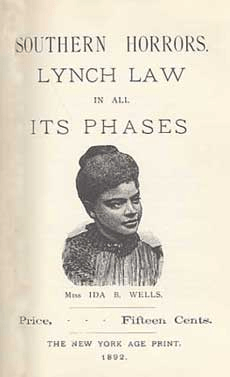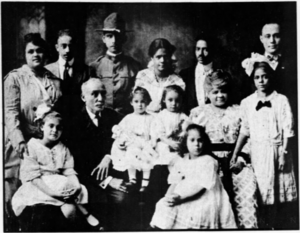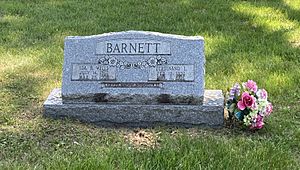Ferdinand Lee Barnett (Chicago) facts for kids
Quick facts for kids
Ferdinand Lee Barnett
|
|
|---|---|
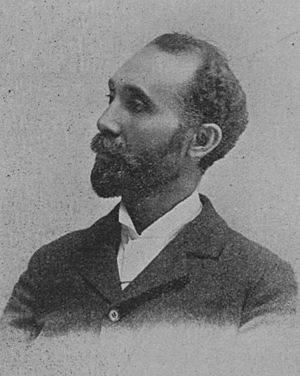
Photo of Barnett from 1900
|
|
| Born | February 18, 1852 |
| Died | March 11, 1936 (aged 84) |
| Resting place | Oak Woods Cemetery |
| Alma mater | Union College of Law |
| Occupation | |
| Political party | Republican, later Democratic |
| Spouse(s) |
|
| Children | 6 (including Alfreda Duster) |
| Relatives | Ferdinand L. Barnett and Alfred S. Barnett (cousins) |
Ferdinand Lee Barnett (born February 18, 1852 – died March 11, 1936) was an important American journalist, lawyer, and civil rights activist. He lived in Chicago, Illinois, starting in the late 1800s. He worked hard to fight for equal rights for African Americans.
Born in Nashville, Tennessee, Ferdinand and his family moved to Windsor, Ontario, Canada, before the American Civil War. After the war, they settled in Chicago. There, Ferdinand finished high school and earned a law degree. He helped start The Chicago Conservator in 1878, a newspaper for African Americans. He was also one of the first Black lawyers in Illinois.
In 1895, Barnett married Ida B. Wells, a famous journalist who fought against lynching. In 1896, he became Illinois' first Black assistant state's attorney. This meant he was a lawyer who worked for the government. The Chicago Defender newspaper called him "one of the foremost citizens Chicago has ever had."
Contents
Early Life and Education
Ferdinand Lee Barnett was born in Nashville, Tennessee, in 1852. His mother, Martha Brooks, was a free woman. His father, also named Ferdinand Lee Barnett, was a blacksmith. He bought his family's freedom in the year Ferdinand was born.
Around 1859, his family moved to Windsor, Ontario, Canada. They did this to escape the Fugitive Slave Act of 1850. This law made it easy for people to kidnap free Black individuals and sell them into slavery.
The Barnett family returned to the United States in 1869 after the American Civil War. They settled in Chicago, Illinois. Ferdinand went to school in Chicago and graduated from Central High School in 1874. After teaching for two years, he studied law at Union College of Law, which is now Northwestern Law School. He became a lawyer in Illinois in 1878. He was the third Black person to become a lawyer in the state.
Fighting for Justice
In December 1877, Ferdinand Barnett helped start a newspaper called the Conservator. The first issue came out on January 1, 1878. This newspaper was a strong voice for justice and equal rights. Barnett quickly became a respected Black leader in Chicago.
He attended important meetings, like the National Conference of Colored Men in Nashville in 1879. There, he gave a speech about the need for unity and education. He also helped lead the Afro-American League in Chicago in 1890.
Working with Ida B. Wells
In 1892, a terrible event happened in Memphis, Tennessee. Three Black men, including a friend of Ida B. Wells, were killed by a white mob. This act, called a lynching, caused a huge outcry across the country. Ferdinand Barnett joined meetings in Chicago to discuss what to do.
Ida B. Wells began to investigate and speak out against lynchings. She showed that lynchings were not about justice but about racism. Wells asked Barnett to help her with a legal case against a newspaper that had attacked her. Barnett agreed to take the case. This was likely how he met Wells, whom he would marry two years later. However, they decided to drop the case because they knew a Black woman would not win with a white jury at that time.
The World's Fair Pamphlet
In 1893, Chicago hosted the World's Columbian Exposition, a big fair. However, it did not include an exhibit for African Americans. Ferdinand Barnett helped write a pamphlet called "The Reason Why the Colored American is not in the World's Columbian Exposition."
This pamphlet explained why African Americans were excluded from the fair. It was published by Barnett, Ida B. Wells, and other important leaders like Frederick Douglass. The pamphlet showed the unfairness of the situation.
Family Life
Ferdinand Barnett's first wife was Mary Henrietta Graham Barnett. She was the first Black woman to graduate from the University of Michigan in 1876. They had two sons, Ferdinand L. and Albert Graham Barnett. Mary died in 1890.
In June 1895, Ferdinand married Ida B. Wells. They had four children: Charles, Herman, Ida B., and Alfreda. Ferdinand and Ida supported each other's work. Shortly before they married, Ida bought Ferdinand's share in the Conservator newspaper. This allowed her to manage the paper while Ferdinand focused on his law career.
Later Career and Legacy
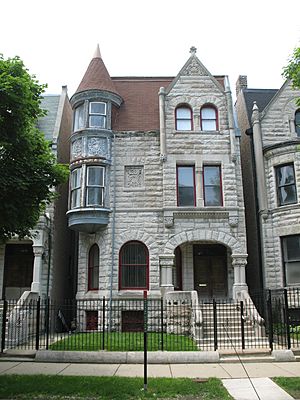
Ferdinand Barnett was an active member of the Republican Party. In 1896, he became the first Black assistant state's attorney in Illinois. He worked on cases involving young people, business issues, and legal procedures. He often appeared before the Illinois Supreme Court and had a good record.
In 1902, Barnett made national news when he spoke about the need for Black people to fight against unfair laws in the South. He continued to be a strong voice for civil rights.
Return to Private Law
Barnett left his government job in 1910 to work as a private lawyer. He often helped African Americans without charging them, especially in cases about unfair hiring practices. He also worked on criminal cases.
In the 1920s, Barnett and his wife supported Marcus Garvey and the Universal Negro Improvement Association, which promoted Black pride and self-reliance. Later, Barnett began to support the Democratic Party.
Ferdinand Lee Barnett passed away on March 11, 1936. He was buried next to Ida B. Wells at Oak Woods Cemetery in Chicago. He is remembered as a dedicated journalist, lawyer, and civil rights leader who fought tirelessly for justice.


